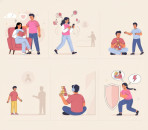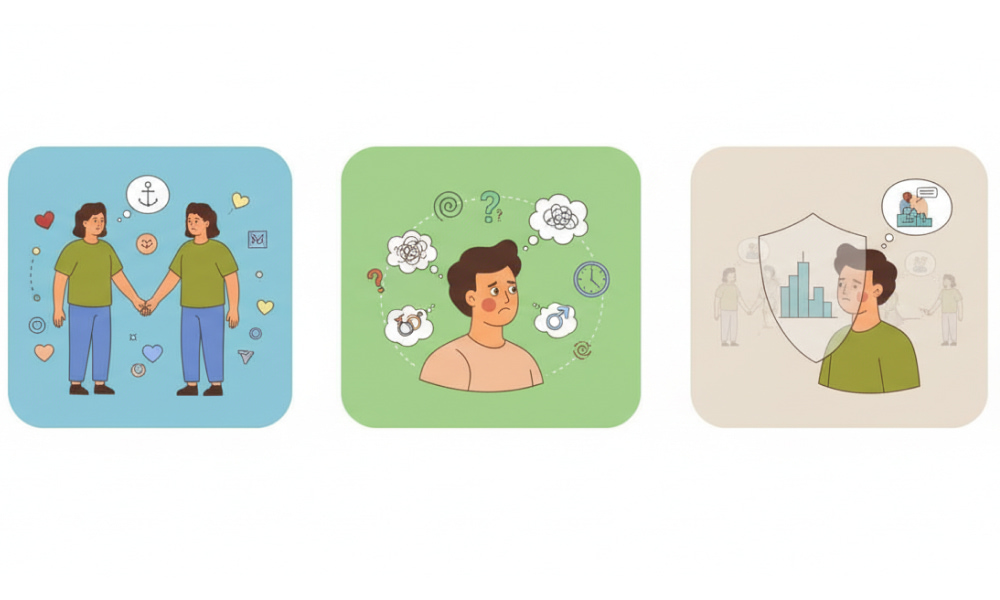What Are the Four Attachment Styles in Adult Relationships?
New Updates



Discover Four Attachment Styles in Relationships
Get StartedFrom Secure to Fearful: What the 4 Types of Attachment Styles Say About You
Most of us crave closeness, yet we protect ourselves when relationship uncertainty triggers old patterns. This paradox sits at the heart of attachment science, a field explaining how early bonding shapes adult expectations, emotional regulation, and conflict responses. The framework clarifies why some people reach for connection while others retreat, and why certain couples feel stuck in repetitive cycles despite genuine affection. Understanding these patterns equips you to communicate needs, rebuild trust, and cultivate secure habits that last.
Mastering Connection Through the Four Attachment Styles
Within clinical literature, the framework of 4 attachment styles psychology offers a shared language for predictable adult bonding behaviors that show up under stress and intimacy. By naming these tendencies, you can replace blurry relational confusion with concrete steps toward healthier connection, including co-regulation and self-soothing skills. This clarity helps partners avoid blame and focus on repair, especially when conversations become heated or misinterpreted. In addition, coaches and therapists use this roadmap to tailor interventions that honor each person’s window of tolerance and nervous system capacity. Many readers also find relief in realizing their reactions are adaptive echoes of early learning rather than fixed flaws.
Across cultures and families, these patterns form a spectrum rather than rigid boxes, yet the categories still provide powerful guidance. Research shows that secure traits can be strengthened through consistent responsiveness, accurate empathy, and clear boundaries. Clinicians often teach micro-habits to shift default reactions toward a warmer, steadier baseline over time. Because the model describes universal dynamics, it can help with friendships, parenting, and leadership as much as romance. For big-picture orientation, many educators summarize the map as the set known as four main attachment styles within human development and adult relationships.

Origins and Core Mechanics: How Attachment Patterns Form and Persist
Attachment learning begins in infancy, when caregivers teach our nervous systems how safe closeness feels and how quickly distress is met. Consistency builds trust, attunement tunes our emotional radar, and repair teaches resilience after inevitable missteps. These early experiences whisper assumptions into adulthood: “People are dependable,” “I must cling to be seen,” “Distance protects me,” or “Love is chaotic.” Because the brain prizes prediction, we recreate familiar scripts unless we deliberately retrain them through new, repeated experiences.
When people seek a precise definition, a common question emerges around what are the four attachment styles as described by developmental and clinical psychology. The cornerstone idea is that bonding patterns are adaptive, meaning they once solved problems in a specific environment even if they now create friction. Rather than labels to judge, the styles function as hypotheses for compassion and skill-building. With that stance, growth becomes a process of updating the body’s expectations through safety, consistency, and choice. Repair conversations, in particular, can rewrite implicit beliefs when they are frequent, predictable, and kind.
Researchers frame the model inside a broader lineage sometimes summarized as attachment theory 4 types, which includes secure, anxious, avoidant, and fearful-avoidant (also called disorganized). Each pattern reflects a different loop between seeking closeness and protecting autonomy. The nervous system learns whether to signal loudly for help, mute needs to avoid disappointment, or vacillate between approach and retreat. Importantly, people often show blends across contexts, such as being more secure with friends than with romantic partners. Recognizing situational nuance helps prevent oversimplification and encourages tailored, flexible practices.
The Four Styles Explained: Secure, Anxious, Avoidant, and Fearful-avoidant
Every style reflects a protective strategy forged by experience, yet all humans can strengthen secure tendencies over time. Secure individuals trust availability while maintaining autonomy, anxious folks amplify bids for reassurance, avoidant people minimize needs to prevent dependence, and fearful-avoidant patterns combine craving with hesitation due to inconsistent or frightening caregiving. Rather than defining a person, these terms describe how stress tilts behavior during closeness or conflict, which means skillful support can shift responses significantly.
In everyday language, many readers want plain descriptions of the set of colloquially called four attachment styles that underlie common relational dynamics. Secure patterns feature balanced closeness and independence with collaborative problem-solving. Anxious patterns prioritize proximity and may protest disconnection through pursuit behaviors. Avoidant patterns emphasize self-reliance and can downplay emotion to feel in control. Fearful-avoidant patterns oscillate, seeking warmth yet bracing for hurt, which produces mixed signals and cycle-driven arguments. These sketches create a starting point for compassionate inquiry rather than a verdict.
- Secure: Comfortable with intimacy, open communication, responsive to needs.
- Anxious: Hyper-vigilant to cues of distance, reassurance-seeking, protest behaviors.
- Avoidant: Values independence, prefers emotional space, difficulty with vulnerability.
- Fearful-Avoidant: Push-pull dynamics, ambivalence about closeness, heightened reactivity.

To capture nuance, clinicians emphasize that the map of 4 types of attachment styles is a heuristic, not a destiny. People often shift across contexts and life phases, especially after therapy, trauma recovery, or secure relationships. Subtypes also exist, offering finer-grained distinctions like dismissing versus fearful patterns within avoidance. Continuous practice micro-celebrations, reliable check-ins, and explicit boundaries can nudge even entrenched habits toward stability. The guiding principle is repetition of safe, chosen connection that feels neither engulfing nor abandoning.
Writers sometimes prefer broader phrasing when discussing the 4 different types of attachment because it underscores both common roots and personal variability. This vocabulary keeps attention on function how a behavior protects the person rather than on moral judgments. With that perspective, partners can co-create rituals of repair, such as pre-agreed signals for pausing, sensory grounding techniques, and scheduled state-of-the-union talks. Over time, adaptive flexibility replaces rigid scripts, and secure relating becomes a practiced skill rather than a lucky accident.
At-a-Glance Comparison and Everyday Examples
A visual summary helps translate abstract concepts into day-to-day behaviors you can recognize in yourself and others. While no chart captures the fullness of a person, quick contrasts reveal predictable stress responses, communication tendencies, and repair preferences. To make application simple, scan the following guide and identify two concrete behaviors you want to practice this week, ideally during low-stakes moments before conflict heats up.
For readers who like structured overviews, this grid organizes the behavioral spectrum often discussed as 4 attachment types across beliefs, triggers, and calming strategies that support growth.
| Style | Core Belief | Stress Trigger | Typical Reaction | Helpful Practice |
|---|---|---|---|---|
| Secure | “I’m worthy and others are reliable.” | Temporary disconnection | Repair and problem-solving | Name needs, invite collaboration |
| Anxious | “Closeness can vanish unless I try hard.” | Ambiguity or delayed replies | Pursuit, rumination, protest | Time-bound reassurance, body-based calming |
| Avoidant | “Dependence risks disappointment.” | High emotional intensity | Withdrawal, minimization | Gradual vulnerability, precise boundaries |
| Fearful-Avoidant | “Love is both wanted and unsafe.” | Unpredictability or conflict | Approach-avoid cycles | Safety rituals, paced exposure to closeness |
After reviewing the grid, you might journal about two moments this week when your reaction matched a pattern, then brainstorm a micro-shift for next time. Many educators describe the broader framework with terms such as four types of attachment to emphasize that these are families of responses rather than rigid identities. In practice, small daily repetitions like naming feelings before problem-solving or agreeing on a repair script create measurable changes. Over months, these habits can rewire expectations and reduce the intensity of protective reflexes.
The Benefits of Learning, Naming, and Updating Attachment Patterns
Knowing your default pattern allows you to anticipate triggers and prepare tools before stress spikes your nervous system. In couples work, that insight transforms arguments into shared puzzles rather than personal attacks. In leadership, the same awareness turns feedback into growth opportunities instead of threats, which elevates psychological safety and team performance. Parents who understand their own scripts can model repair and teach kids emotional literacy long before adolescence adds complexity.
Many practitioners tailor interventions for the landscape sometimes labeled 4 adult attachment styles because adulthood adds layers like career pressure, cohabitation, caregiving, and digital communication. With targeted practices such as time-boxed reassurance, sensory grounding, and explicit check-ins partners create stability even during disruption. The most profound benefit is permission to be a work in progress, which reduces shame and increases motivation to try again after missteps. As self-compassion grows, defensive spikes soften, and curiosity takes the driver’s seat in tough conversations.
From a systems perspective, the broad category phrasing of 4 types of attachment helps communities build shared language for support, boundaries, and conflict repair. Workplaces can normalize needs for recovery after intense projects, while families can design rituals that re-center connection after busy weeks. Over time, secure norms replace hypervigilance and disengagement with consistent availability and choice. When people trust repair, courage to be honest increases, and relationships become engines for learning rather than arenas of fear.
- Improved conflict resolution and faster repair after ruptures.
- Greater ability to name needs without blame or paralysis.
- Clearer boundaries that protect intimacy rather than block it.
- Lower physiological arousal during hard talks, enabling empathy.
- Expanded capacity for joy, play, and collaborative problem-solving.
Attachment in Daily Relationships: Communication, Boundaries, and Repair
Everyday interactions missed texts, tone of voice, weekend plans can activate protective habits faster than logic can catch them. Once you recognize your pattern, you can preempt spirals by agreeing on signals, time-outs, and reunion rituals. For example, anxious-leaning partners might plan predictable check-ins during busy days, while avoidant-leaning partners may request a brief pause before diving into difficult topics. The magic lives in negotiation, where both people feel considered and both nervous systems feel safe enough to stay open. Practical coaching often references themes associated with 4 attachment styles in relationships to match tools with predictable conflict loops. Pursuers can practice soft start-ups and somatic calmers before initiating heavy topics. Distancers can practice naming internal states and offering small, time-bound doses of closeness. Couples can co-create a repair script that begins with appreciation, includes one concrete request, and ends with a check for understanding. These sequences turn arguments into learnable, repeatable skills.

When mapping common conflict patterns, facilitators sometimes group behaviors under umbrella phrases like 4 relationship attachment styles to keep guidance practical. Two-way empathy becomes foundational: you accept your partner’s protective reflex as meaningful data while also honoring your needs. Boundaries shift from walls to agreements, and listening expands beyond words to include pace, proximity, and body language. With repetition, partners internalize trust that disconnection is temporary and repair is reliable.
- Create “time, topic, tone” agreements for tough conversations.
- Use a one-minute body scan before responding under stress.
- Adopt a shared signal to pause and resume without punishment.
- Schedule weekly state-of-the-union talks to prevent backlog.
Assessment and Healing: Quizzes, Therapy, and Daily Practice
Self-assessment offers a gentle entry point, especially if you treat results as a snapshot rather than a verdict. Reflective journals, therapist-guided interviews, and structured questionnaires help you notice patterns without self-criticism. After identifying common triggers, you can experiment with small, repeatable practices that nudge reactions toward security. The goal is not perfection, but faster recovery, clearer communication, and a wider window of tolerance during relational stress. For a playful check-in, many readers try tools similar to a 4 attachment styles quiz before exploring deeper with a clinician or coach. Short assessments can reveal tendencies worth testing in real life, such as how you respond when plans change or when silence stretches between messages. Therapy approaches like Emotionally Focused Therapy, Internal Family Systems, and somatic modalities provide richer pathways for rewriting old predictions. Most progress happens between sessions, where daily reps, micro-requests, gratitude notes, and grounding build new neural grooves.
As you personalize a growth plan, it helps to anchor your goals to the broader map frequently summarized as 4 attachment styles so you can track shifts over time. Keep interventions concrete and observable, such as “ask for a 10-minute debrief after conflicts” or “practice naming one feeling and one need before proposing solutions.” Celebrate tiny wins to reinforce learning and reduce shame. With steady repetition and supportive community, security becomes less a trait and more a practiced capacity you can rely on.
- Choose one regulation tool: breath, movement, or sensory grounding.
- Set a recurring check-in with a friend or partner to practice naming needs.
- Draft a repair checklist you can read when emotions surge.
- Capture weekly reflections to notice trendlines and celebrate changes.
Discover Four Attachment Styles in Relationships
Get StartedFrequently Asked Questions
-
How fixed are attachment styles over a lifetime?
They are plastic rather than permanent, because the nervous system updates with repeated safe experiences. Supportive relationships, consistent self-regulation, and effective therapy can all promote movement toward greater security. Many people see measurable change when they pair awareness with daily, doable practices. The key is repetition under conditions that feel both chosen and safe.
-
Can someone have a mix of styles depending on the situation?
Yes, context often shapes expression, and blends are common across work, friendship, and romance. Stress levels, the other person’s behavior, and the stakes of an interaction can all tilt responses. Tracking patterns over weeks gives a more accurate picture than one-off moments. Think of styles as tendencies under pressure, not fixed identities.
-
What’s the fastest way to build more secure habits?
Start with regulation, because a calmer body makes better choices possible. Then add predictable connection rituals, such as daily appreciations and scheduled check-ins, to reduce ambiguity. Practice repair scripts so that missteps become learning opportunities. Over time, these routines rewire expectations about safety and closeness.
-
How should partners talk about attachment without blaming?
Use curiosity and shared language, framing behaviors as protection rather than flaws. Agree on simple signals to pause and resume hard talks, which reduces escalation. When each person names one feeling and one need, conversations stay focused and compassionate. Appreciation at the start and end of tough dialogues also buffers defensiveness.
-
Do individual therapies help even if a partner isn’t involved?
Absolutely, because personal regulation and clear boundaries improve every interaction. Individual work can stabilize triggers, expand tolerance, and clarify requests you bring to relationships. As your capacity grows, you often model secure behaviors that invite reciprocity. Many couples benefit when even one person practices steady, transparent repair.
 The 4 Attachment Styles: A Comprehensive Guide
The 4 Attachment Styles: A Comprehensive Guide